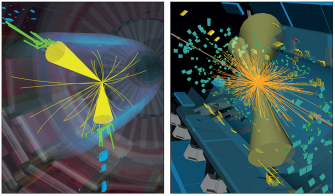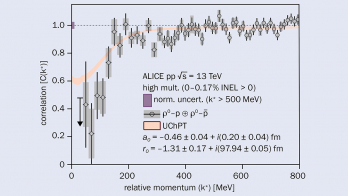
The production of different types of hadrons provides insights into one of the most fundamental transitions in nature – the “hadronisation” of highly energetic partons into hadrons with confined colour charge. To understand how this transition takes place we have to rely on measurements, and measurement-driven modelling. This is because the strong interaction processes that govern hadronisation are characterised by a scale given by the typical size of hadrons – about 1 fm – and cannot be calculated with perturbative techniques. The ALICE collaboration has recently performed a novel study of hadronisation by comparing the production of strange neutral baryons and mesons inside and outside of charged-particle jets.
One of the ways to contrast baryon and meson production is to analyse the ratio of their momentum distributions. This has been done in most of the collision systems, but the comparison is particularly interesting in heavy-ion collisions, where a large baryon-to-meson enhancement is often referred to as the “baryon anomaly”. A characteristic maximum at intermediate transverse momenta (1–5 GeV) is found in all systems, but in Pb–Pb collisions the ratio is strongly increased, to the extent that it exceeds unity, implying the production of more baryons than mesons. The rise of the ratio has been associated with either hadron formation from the recombination of two or three quarks, or the migration of the heavier baryons to higher momenta by the strong all-particle “radial” flow associated with the production and expansion of a quark–gluon plasma.
A recent result adds an extra twist to the study of strange baryons and mesons
The ALICE collaboration has studied baryon-to-meson ratios extensively. A recent result adds an extra twist to the study of strange baryons and mesons by studying the ratios in two parts of the events separately – inside jets and in the event portion perpendicular to a jet cone. This allows physicists to look “under the peak” to reveal more about its origin. The latest study focuses on the neutral and weakly decaying Λ baryon and K0S meson – particles often known collectively as V0 due to their decay particles forming a “V” within a detector. The ALICE detector can reconstruct these decaying particles reliably even at high momenta via invariant-mass analysis using the charged-particle tracks seen in the detectors.
The particles associated with the jets show the typical ratio known from the high momentum tail of the inclusive baryon-to-meson distribution – essentially no enhancement – and similar values were found in both pp and p–Pb collisions, consistent with simulations of hard pp collisions using PYTHIA 8 (see figure 1). By contrast, the particles found away from jets do indeed show a baryon-to-meson enhancement that qualitatively resembles the observations in Pb–Pb collisions. The new study clarifies that the high rise of the ratio is associated with the soft part of the events (regions where no jet with more than pT = 10 GeV is produced) and brings the first quantitative guidance for modelling the baryon-to-meson enhancement with an additional important constraint – the absence of the jet. Moreover, finding that the “within-jet” ratio is similar in pp and p–Pb collisions, while the “out-of-jet” ratio shows larger values in p–Pb than in pp collisions, gives even more to ponder about the possible origin of the effect in relation to an expanding strongly interacting system. Future measurements involving multi-strange baryons may shed further light on this question.







